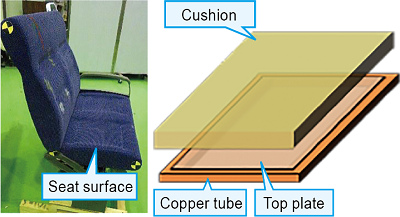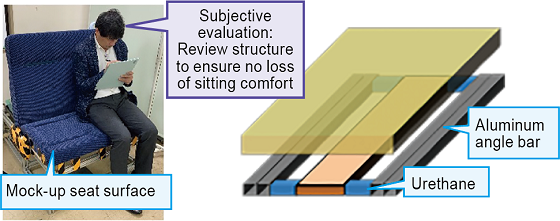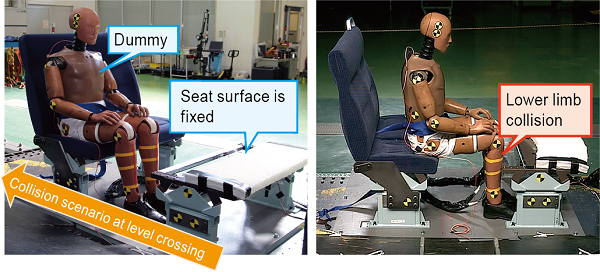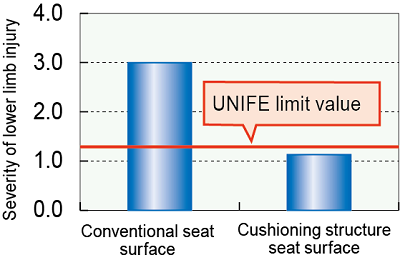11. Seat surfaces for minimizing injuries to passengers in the event of a collision
When passengers are seated on seats arranged laterally (in the direction of sleepers), e.g., on the walkover seat fitted in suburban vehicles, they can suffer lower limb injuries if they are thrown forward into the seat in front of them by the impact of a train collision.
This risk has been highlighted in past railway accident investigation reports. In Europe and the U.S., there are regulations aimed at limiting the severity of injuries, and in some cases seats are even fixed in a non-convertible structure to help minimize injury severity.
Up to now in Japan, however, the severity of injuries has not been assessed in this context.
In light of this, we developed a seat surface capable of reducing the severity of lower limb injury in the event of a collision.
In the seat surface structure of a conventional seat, the cushioning is typically supported from below by a top plate surrounded by highly rigid steel pipe (Fig. 1).
This structure is a factor that tends to worsen severity of injuries that occur when a passenger’s lower limbs collide with the seat in front of them. Therefore, after subjectively evaluating the structure to ensure that there is no loss of sitting comfort, we devised a cushioning structure such that the part where a passenger’s lower limbs would impact is made of aluminum angle and supported by urethane at both ends (Fig. 2).
To confirm the effectiveness of this structure in reducing injuries, we fabricated a prototype seat surface and conducted a sled test under a hypothetical level crossing accident (Fig. 3).
Our findings confirmed that the new seat reduced the severity of lower limb injury by about 60% compared to conventional seating surfaces.
This is even lower than the injury severity limit stipulated in the technical report of the European Rail Supply Industry Association (UNIFE), which is widely referenced for evaluations
in Europe and other countries (Fig. 4).
Since a substantial shock-absorbing effect can be achieved with only the seat surface, when railway operators develop seats aimed at mitigating injury risks in the event of a collision, this new design can be introduced without any major change to existing seat designs.
Other Contents
- 1. Earthquake early warning method for the earthquake source fault regions
- 2. Design method for bearing parts to control damage and improve restorability
- 3. Method for verifying the restorability of railway structures considering small-and medium-scale earthquakes
- 4. Method for evaluating vehicle safety in strong winds using probabilistic risk assessment
- 5. Inspection of gaps by hammering slab track filling layers and prediction of deterioration
- 6. Method for estimating snow accretion and snow dropping of a train vehicle for investigating countermeasures against snow dropping
- 7. Method of applying image processing-based object detection and obstacle determination to safety applications
- 8. Support system for preventing a decline in alertness level of drivers
- 9. Phased array ultrasonic testing method for easy detection of flaws in bogie frame welds
- 10. Oil for axle-box for Shinkansen with excellent low-temperature performance and maintainability
- 11. Seat surfaces for minimizing injuries to passengers in the event of a collision
- 1. Earthquake early warning method for the earthquake source fault regions
- 2. Design method for bearing parts to control damage and improve restorability
- 3. Method for verifying the restorability of railway structures considering small-and medium-scale earthquakes
- 4. Method for evaluating vehicle safety in strong winds using probabilistic risk assessment
- 5. Inspection of gaps by hammering slab track filling layers and prediction of deterioration
- 6. Method for estimating snow accretion and snow dropping of a train vehicle for investigating countermeasures against snow dropping
- 7. Method of applying image processing-based object detection and obstacle determination to safety applications
- 8. Support system for preventing a decline in alertness level of drivers
- 9. Phased array ultrasonic testing method for easy detection of flaws in bogie frame welds
- 10. Oil for axle-box for Shinkansen with excellent low-temperature performance and maintainability
- 11. Seat surfaces for minimizing injuries to passengers in the event of a collision




